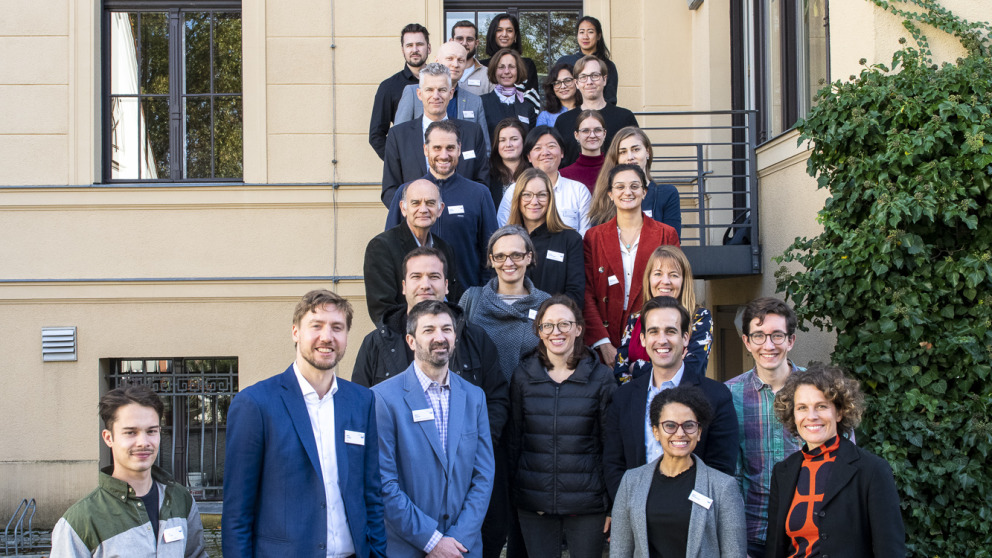Decarbonisation of construction and industry
22.11.2023

Nino Jordan, currently Klaus Töpfer Sustainability Fellow at RIFS and Associate Professor at University College London (UCL), and Rixt van der Valk, PhD candidate at UCL, brought together experts involved with the Buy Clean movement in the USA and with regulations limiting carbon emissions from construction materials in Denmark, the Netherlands and France. In interactive sessions they explored the limitations and potentials of different policies designed to cap the carbon footprints of industrial products and buildings.
The housing shortage is growing worldwide. It doesn't take a fortune teller to predict that CO2 emissions from buildings will become increasingly significant. CO2 emissions are generated not only during the use of buildings, but also during their construction and eventual deconstruction. How are CO2 emissions distributed across the life cycle?
Rixt van der Valk (R. vdV): Globally, the built environment is responsible for approximately 14 gigatons of carbon each year, which is around 40 per cent of global energy-related carbon emissions in total. About 27 per cent of global carbon emissions are operational, meaning that they are generated during the utilization of the building. The other 13 per cent are embodied emissions, associated with the extraction, manufacturing, transport, and sometimes even dismantling/end of life of materials and products in the built environment. Within the embodied emission life cycle stages, the biggest contributor of carbon is the production of building materials such as cement and steel.
Why are carbon footprint policies necessary to decarbonize the building industry?
R. vdV.: Most policies so far have focused on operational carbon reduction. These policies do not address the other 13 per cent of global greenhouse gas (GHG) emissions which the built environment is responsible for, namely embodied emissions. If we want to meet the goal established in the Paris Agreement of keeping global temperature rise well below 2 C, and limiting it to 1.5 C, it is inescapable that policies are necessary that focus on emissions across the whole life cycle.
Carbon pricing is the EU’s flagship policy for tackling climate change. Why is that not enough for decarbonising industry and construction?
Nino Jordan (N. J.): The EU has been worried that an effective carbon price on carbon intensive, trade-exposed sectors would lead to competitive advantages for regions with no or lower carbon prices. That’s why they have allocated free emissions permits to certain industries, such as steel and cement. Those industries have been effectively shielded from carbon pricing. Now the EU’s Carbon Border Adjustment Mechanism (CBAM) is supposed to solve the problem by fading-in carbon pricing for importers while fading-out free emissions for domestic industry. However, this is a slow and uncertain process and current political developments in member states make it risky to put all your chips on the sustained climate ambition of the EU. Also, in the USA there is no carbon price at the federal level and so other measures are needed.
What is so special about the Buy Clean movement in the USA? Can you describe it in one sentence? Could it be a blueprint for the European Union?
R. vd V: The Buy Clean movement is a great example of a sub-national policy initiative that brings together industry and governmental actors to address the problem of embodied carbon emissions in the built environment. It has been embraced by multiple states in the US and has also been incorporated into the Inflation Reduction Act. It is a good instrument as part of a tool-box of approaches for reducing embodied carbon emissions.
The United Nations Industrial Development Organization coordinates the Clean Energy Ministerial Industrial Deep Decarbonisation Initiative (IDDI), which is working on government pledges to procure low carbon materials. Are we likely to see more public and private pledges to buy ultra-low carbon products?
N. J.: I think we are, eventually, going to see increasingly ambitious public and private pledges to buy ultra-low carbon products. The question is whether this will occur fast enough and who will show real leadership.
How do Denmark’s carbon thresholds for building lifecycle emissions work?
R. vd V :Danish building regulations require that a buildings’ whole life carbon emissions be calculated at the planning stage and not exceed certain limit values.
The Dutch mandatory maximum threshold for buildings comprises an environmental lifecycle assessment (LCA) for 11 impact categories, including embodied carbon. What are its advantages versus the Danish approach?
R. vd V: The Global Warming Potential (GWP) of carbon dioxide and other greenhouse gases is a very important environmental indicator, but it is not the only one. Other pollutants in the lifecycle of products can also heavily impact the environment, and many of these are included in the Dutch mandatory threshold. This approach could help to mitigate disproportionate increases in other environmental impacts as a result of efforts to reduce carbon intensity.
What are the next steps for advancing carbon footprint policies for the construction and industrial sectors? Do the advantages of mandatory whole-life/embodied carbon standards outweigh the challenges for policymakers and industry?
R. vd V.: It is clear that we will see more countries adopting carbon footprint policies. The more difficult question is: what approach should these policies take? There are different advantages and disadvantages to adopting policies focusing on either materials or buildings, and using regulatory, economic or strategic investment instruments, or a combination thereof. I suspect that we will see a mixture of all of these.
N. J.: The conference has shown that concrete policies already exist in practice. Now we need to learn from them, tinker around the edges and adapt to local conditions.
The interview with the two was conducted by Christina Camier.
More information:
Grubb, Michael and Jordan, Nino David and Hertwich, Edgar and Neuhoff, Karsten and Das, Kasturi and Bandyopadhyay, Kaushik Ranjan and van Asselt, Harro and Sato, Misato and Wang, Ranran and Pizer, William A. and Oh, Hyungna, Carbon Leakage, Consumption, and Trade (October 2022). Annual Review of Environment and Resources, Vol. 47, pp. 753-795, 2022. Available at SSRN: https://ssrn.com/abstract=4252380 or http://dx.doi.org/10.1146/annurev-environ-120820-053625





